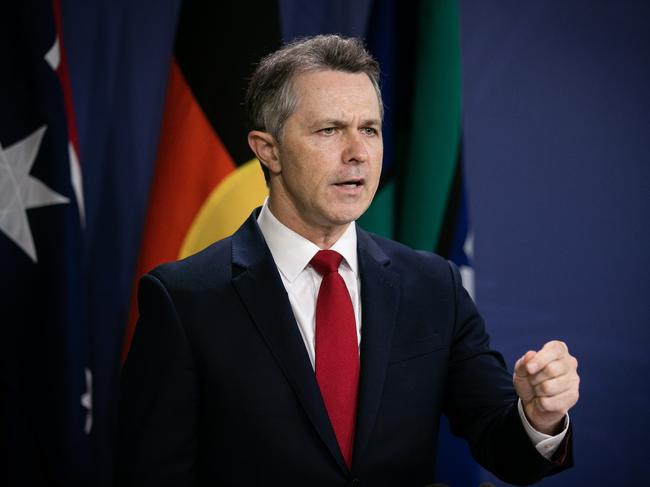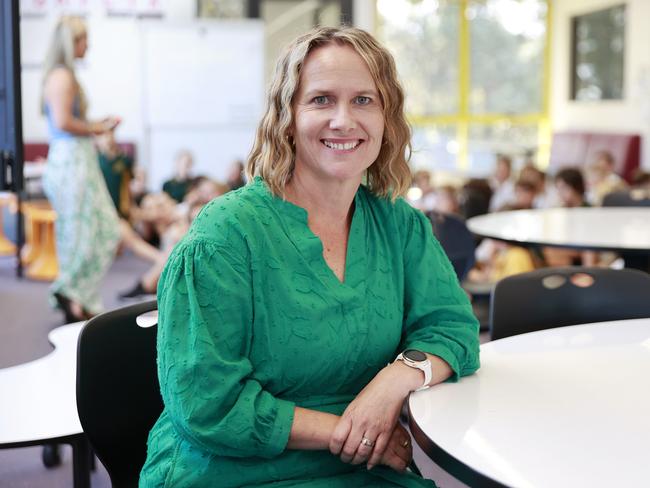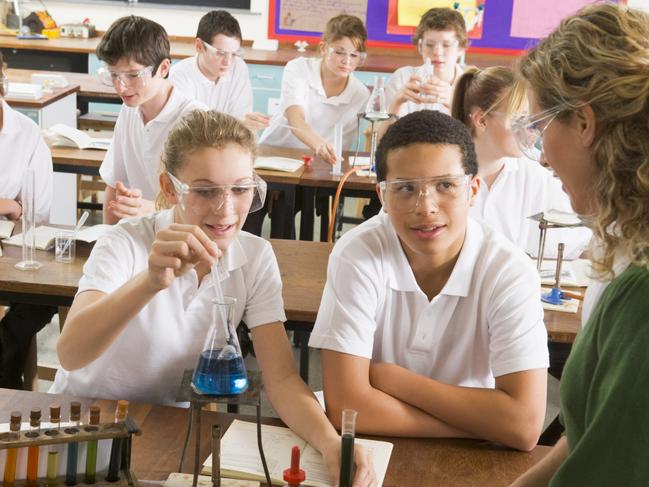‘Crisis’ point: New three-pronged plan to fix Australia’s schools
As educators quit in droves and students’ scores decline by up to 22 per cent, federal authorities have announced the biggest education shake-up in a decade. Here’s what they plan to do to.
National
Don't miss out on the headlines from National. Followed categories will be added to My News.
Australia’s entire education system is in need of massive reform, with the federal government warning the nation is in a teaching “crisis” and launching the biggest overhaul of the sector in a decade.
Education Minister Jason Clare is waging a triple attack on systemic problems in tertiary and secondary education as well as a revolutionary drive to focus on early learning, saying now is Australia’s “last chance” to get it right.
The Minister wants to collaborate more closely with state and territory counterparts to identify “the secret sauce” of the nation’s best schools and inject it into those who are falling behind.
Mr Clare News Corp Australia the number of teachers deserting the job was “scary” and has tasked Sydney University chief and education supremo Mark Scott with supercharging the way teaching is taught to attract more people into the profession.
Over the past 10 years teaching enrolments have plummeted by 16 per cent and up to half desert the profession in the first five years on the job yet demand for teachers is at record highs and shortages abound.
A study by Monash University which surveyed almost 5,500 teachers found a staggering 70 per cent believed that the public did not respect them.
The Minister also said Australia’s messy education system — in which states and territories oversee primary and secondary schools with different rules and then feed kids into a national tertiary system — needed “serious reform”.
The national agreement that is supposed to harmonise the system was effectively useless, he said.
The minister confirmed he’ll meet with state and federal counterparts in the coming weeks to begin negotiating a new national agreement, after taking on the Productivity Commission’s “blistering criticism” of the current National School Reform Agreement.
“The next one will” have concrete targets and practical reforms, he promised. The terms of reference and an advisory team will be finalised shortly.
“Today, if you’re a child from a poor family, you’re less likely to go to preschool, more likely to fall behind. You’re less likely to finish high school and you’re less likely to finish university,” he said.
“This is an opportunity to change that.”

While the Albanese government remains set on seeing schools fully funded, that won’t come instantly. Funding for public schools will continue to rise up to 95 per cent of the school resourcing standard over the next six years but the remaining five per cent gap is still up for negotiation with the states and territories.
“Funding is important … but so is what it’s spent on, what it’s invested in, and here is our last best chance to get this right – to make sure that we’re funding the sorts of things that are going to help children who fall behind,” Mr Clare said.
Mr Clare rejected criticism of the collaboration between the states and territories, saying he and his counterparts “work very well together”.
However, more work could be done in how the group identifies best practice at high achieving schools across the country, he admitted.
“What’s the magic? What’s the secret sauce that you can find in some schools, that we can identify and make sure that we roll out into other schools,” he said.
“ACARA has done some of that work for us, but I think there’s a lot more that we can do there (to) make sure that we capture the magic and make sure that every school gets that opportunity.”

In Sydney, experts agree one outstanding school is Curl Curl North.
Curl Curl North Public, which finished an extensive $49 million re-build and renovation in 2021, boasts state-of-the-art facilities, with flexible classrooms and all the latest tech gadgets.
The playground facilities include futsal and basketball courts, and shade is provided by flora and fauna native to the northern beaches.
The design ensures the classrooms stay cool in summer and warm in winter allowing kids to focus on their work.

North Curl Curl Public Principal Donna Blatchford said she can’t believe her luck in leading a school with such fantastic facilities and said the design gives kids a better learning experience.
“I am proud to lead such an innovative school,” Ms Blatchford said. “We are very lucky here.”
Students Jackson and Paige, both 11, sang the praises of both their school and their teachers.
“If you need help the teachers will always help you and there are different ways to learn,” Jackson said.
While Paige said her friends and teachers “feel like my family”.

In the decade between 2009 and 2018 overall funding for government schools rose from $26.4 billion to $39.2 billion and yet over the same period performance dropped by 22 per cent in both mathematical and scientific literacy, according to the Program for International Student Assessment (PISA), while reading performance was unchanged.
Mr Clare also declared he would deliver more access to preschool, which would revolutionise the lives of disadvantaged and Indigenous kids.
“The first five years are everything,” he said.
In a frank interview with News Corp Australia, Mr Clare said he was stunned when he learned the burnout rate of teachers.
“One of the things that’s blown my mind is that 30 to 50 per cent of teachers quit in the first five years,” he said.
“Now some teachers are telling their kids don’t become a teacher when we need them more than ever.

“That’s scary. That tells you we’ve got a crisis and we’ve got to turn it around.”
Mr Clare also said the current arrangements between states and territories and the commonwealth was a mess, with a national agreement that essentially does nothing.
“That agreement doesn’t have any targets for what we should be trying to achieve or any practical framework to get there,” he said.
The Minister said a critical focus would be ensuring kids from poor and working-class backgrounds, kids from the bush and indigenous kids all had the same access to education that those from wealthier families did.
“If you’re a child from a poor background you’re less likely to go to preschool, your less likely to finish high school and you’re less likely to go to uni,” he said.
“That’s the awful truth.”
Mr Clare said of his three-pronged overhaul: “All three together constitute the biggest review and reform of education in more than a decade …
“This is our last best chance to get this right. If we don’t act now it will be too late.”
More Coverage
Originally published as ‘Crisis’ point: New three-pronged plan to fix Australia’s schools
Read related topics:Best in Class




